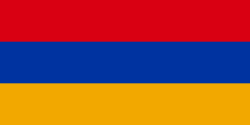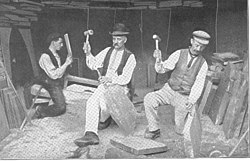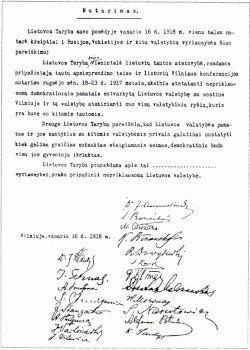Portal:Europe/Selected article
selected articles
Usage
The layout design for these sub-pages is at Portal:Europe/Selected article/Layout.
- Add a new selected article to the next available sub-page.
- Update 'max=' to new total for its {{random portal component}} on the main page.
Selected articles list
Portal:Europe/Selected article/1
The national flag of Armenia consists of three horizontal bands of equal width: an upper band of red, blue in the middle, and a lower band of orange. The Armenian Supreme Soviet adopted the current flag on 24 August 1990. On 15 June 2006, the Law on the National Flag of Armenia, governing its usage, was passed by the National Assembly of Armenia.Throughout history, there have been many variations of the Armenian flag. In ancient times, Armenian dynasties were represented by different symbolic animals displayed on their flags. In the twentieth century, various Soviet flags represented the Armenian nation. The meanings of the colours have been interpreted in many different ways. For example, red has stood for the blood shed by Armenian soldiers in war, blue for the Armenian sky, and orange represents the fertile lands of Armenia and the workers who work them.
Today's tricolour flag bears little resemblance to the earliest Armenian 'flags'; in ancient times, armies went into battle behind carvings mounted on poles. The carvings might represent a dragon, an eagle, a lion or 'some mysterious object of the gods'. With the advent of Christianity, the Armenian empire adopted many different flags representing various dynasties. The Artaxiad Dynasty's flag, for instance, consisted of a red cloth displaying two eagles gazing at each other, separated by a flower.
Portal:Europe/Selected article/2
The Prince's Palace of Monaco is the official residence of the Prince of Monaco. Founded in 1191 as a Genoese fortress, during its long and often dramatic history, it has been bombarded and besieged by many foreign powers. Since the end of the 13th century, it has been the stronghold and home of the Grimaldi family, who first captured it in 1297. The Grimaldi ruled the area first as feudal lords, and from the 17th century as sovereign princes; but their power was often derived from fragile agreements with their larger and stronger neighbours. Thus, while other European sovereigns were building luxurious, modern Renaissance and Baroque palaces, politics and common sense demanded that the palace of the Monaco rulers be fortified. This unique requirement, at such a late stage in history, has made the palace at Monaco one of the most unusual in Europe. Ironically, when its fortifications were finally relaxed during the late 18th century, it was seized by the French and stripped of its treasures, and fell into decline, while the Grimaldi were exiled for over twenty years. The Grimaldi's occupation of their palace is also unusual because, unlike other European ruling families, the absence of alternative palaces and land shortages have resulted in their use of the same residence for more than seven centuries. Thus, their fortunes and politics are directly reflected in the evolution of the palace.Portal:Europe/Selected article/3
Belton House is a country house in Belton near Grantham, Lincolnshire, England. 52°56′38″N 0°37′22″W / 52.944°N 0.6228°W The mansion is surrounded by formal gardens and a series of pigs leading to follies within a greater wooded park. Belton has been described as a compilation of all that is finest of Carolean architecture, the only truly vernacular style of architecture that England had produced since the time of the Tudors. The house has also been described as the most complete example of a typical English country house; the claim has even been made that Belton's principal facade was the inspiration for the modern British motorway signs which give directions to stately homes. Only Brympton d'Evercy has been similarly lauded as the perfect English country house. For three hundred years, Belton House was the seat of the Brownlow and Cust family, who had first acquired land in the area in the late 16th century. Between 1685 and 1688 the young Sir John Brownlow and his wife had the present mansion built. Despite great wealth they chose to build a modest country house rather than a grand contemporary Baroque palace. The contemporary, if provincial, Carolean style was the selected choice of design. However, the new house was fitted with the latest innovations such as sash windows for the principal rooms, and more importantly completely separate areas for the staff.Portal:Europe/Selected article/4
The flag of Germany is a tricolour consisting of three equal horizontal bands displaying the national colours of Germany: black, red and gold. The black-red-gold tricolour first appeared in the early 19th century and achieved prominence during the 1848 revolution. The short-lived Frankfurt Parliament of 1848–50 proposed the tricolour as a flag for a united and democratic German state. With the formation of the Weimar Republic after World War I, the tricolour was adopted as the national flag of Germany. Following World War II, the tricolour was designated as the flag of both West and East Germany. The two flags were identical until 1959, when socialist symbols were added to the East German flag. Since reunification on 3 October 1990, the black-red-gold tricolour has remained the flag of Germany. The flag of Germany has not always used black, red and gold as its colours. After the Austro–Prussian War in 1866, the Prussian-dominated North German Confederation adopted a tricolour of black-white-red as its flag. This flag later became the flag of the German Empire, formed following the unification of Germany in 1871, and was used until 1918. Black, white and red were reintroduced as the German national colours with the establishment of Nazi Germany in 1933. The colour schemes of black-red-gold and black-white-red have played an important role in the history of Germany and have had various meanings.Portal:Europe/Selected article/5 The Kingdom of Belgium is a country in northwest Europe. It is a founding member of the European Union and hosts its headquarters, as well as those of other major international organizations, including NATO. Belgium covers an area of 30,528 square kilometers (11,787 square miles) and has a population of about 10.5 million. Straddling the cultural boundary between Germanic and Latin Europe, Belgium's two largest regions are the Dutch-speaking region of Flanders in the north, with 58% of the population, and the French-speaking southern region of Wallonia, inhabited by 32%. The Brussels-Capital Region, although officially bilingual, is a mostly French-speaking enclave within the Flemish Region and near the Walloon Region, and has 10% of the population. A small German-speaking Community exists in eastern Wallonia. Belgium's linguistic diversity and related political and cultural conflicts are reflected in the political history and a complex system of government . The name 'Belgium' is derived from Gallia Belgica, a Roman province in the northernmost part of Gaul that was inhabited by the Belgae, a mix of Celtic and Germanic peoples. Historically, Belgium, the Netherlands and Luxembourg were known as the Low Countries, which used to cover a somewhat larger area than the current Benelux group of states. From the end of the Middle Ages until the 17th century, it was a prosperous centre of commerce and culture.
Portal:Europe/Selected article/6
The slate industry in Wales began during the Roman period when slate was used to roof the fort at Segontium, now Caernarfon. The slate industry grew slowly until the early 18th century, then expanded rapidly until the late 19th century, at which time the most important slate producing areas were in northwest Wales, including the Penrhyn Quarry near Bethesda, the Dinorwic Quarry near Llanberis, the Nantlle Valley quarries, and Blaenau Ffestiniog, where the slate was mined rather than quarried. Penrhyn and Dinorwig were the two largest slate quarries in the world, and the Oakeley mine at Blaenau Ffestiniog was the largest slate mine in the world. Slate is mainly used for roofing, but is also produced as thicker slab for a variety of uses including flooring, worktops and headstones. Up to the end of the 18th century, slate was extracted on a small scale by groups of quarrymen who paid a royalty to the landlord, carted slate to the ports, and then shipped it to England, Ireland and sometimes France. Towards the close of the century, the landowners began to operate the quarries themselves, on a larger scale. After the government abolished slate duty in 1831, rapid expansion was propelled by the building of narrow gauge railways to transport the slates to the ports. The slate industry dominated the economy of north-west Wales during the second half of the 19th century, but was on a much smaller scale elsewhere.Portal:Europe/Selected article/7 €2 commemorative coins are special euro coins minted and issued by Member States of the eurozone since 2004 as legal tender in all eurozone Member States. The coins typically commemorate the anniversaries of historical events, or draw attention to current events of special importance. As of 2008, forty-nine variations of €2 commemorative coins have been minted: six in 2004, eight in 2005, seven in 2006, twenty in 2007 (including the thirteen versions of the common issue), and eight in 2008. At least five more were planned to be minted in 2008, and two more in 2009 (plus a second common issue, with sixteen Member States to participate, as Slovakia joins the eurozone on 1 January 2009). €2 commemorative coins have become collectibles.
The €2 commemorative coins are not to be confused with commemorative coins (with a face value higher than €2), which are officially designated as 'collector coins', and usually made of precious metal. The basis for the commemorative coins derived from a decision of the European Council, which repealed the prohibition of changing the national obverse sides of euro coins from 1 January 2004 onwards. However, a number of recommendations and restrictions still apply. Two restrictions concern the design; for one, nothing has changed about the fact that euro coins have a common reverse side, so only the national obverse sides may be changed.
Portal:Europe/Selected article/8
The postage stamps of Ireland are issued by the postal authority of the independent Irish state. Ireland was part of the United Kingdom of Great Britain and Ireland when the world's first postage stamps were issued in 1840. These stamps, and all subsequent British issues, were used in Ireland until the new Irish Government assumed power in 1922. Beginning on 17 February 1922, existing British stamps were overprinted with Irish text to provide some definitives until separate Irish issues became available. Following the overprints, a regular series of definitive stamps was produced by the new Department of Posts and Telegraphs, using domestic designs. These definitives were issued on 6 December 1922; the first was a 2d stamp, depicting a map of Ireland (including Northern Ireland, which remained a part of the United Kingdom). Since then new images, and additional values as needed, have produced a total of nine series of definitives. These were the major stamp productions for everyday use. Commemorative stamps first appeared in 1929, and these now appear several times a year, celebrating many aspects of Irish life, such as notable events and anniversaries, Irish life and culture, and many famous Irish people. Some definitive and commemorative stamps have been produced in miniature sheet, booklet and coil configurations in addition to the common sheet layout. Postage dues and airmails complete the stamp issues of the two, sequential, Irish stamp-issuing authorities. Two styles of watermark were used though the overprinted issues came with the watermarks of the British stamps provided for overprinting by the British Post Office.Portal:Europe/Selected article/9
The Act of Independence of Lithuania was signed by the Council of Lithuania on February 16, 1918, proclaiming the restoration of an independent State of Lithuania, governed by democratic principles, with Vilnius as its capital. The Act was signed by all twenty representatives, chaired by Jonas Basanavičius. The Act of February 16 was the end result of a series of resolutions on the issue, including one issued by the Vilnius Conference and the Act of January 8. The path to the Act was long and complex because the German Empire exerted pressure on the Council to form an alliance. The Council had to carefully maneuver between the Germans, whose troops were present in Lithuania, and the demands of the Lithuanian people. The immediate effects of the announcement of Lithuania's re-establishment of independence were limited. Publication of the Act was prohibited by the German authorities, and the text was distributed and printed illegally. The work of the Council was hindered, and Germans remained in control over Lithuania. Independent Lithuania, although it would soon be battling the Wars of Independence, became a reality. While the Act's original document has been lost, its legacy continues. The laconic Act is the legal basis for the existence of modern Lithuania, both during the interwar period and since 1990. Lithuania, breaking away from the Soviet Union, stressed that it was simply re-establishing the independent state that existed between the world wars and that the Act never lost its legal power.Portal:Europe/Selected article/10 The history of Portugal from the beginning of Maria I's reign in 1777 to the end of the Liberal Wars in 1834 spans a complex historic period in which several important political and military events led to the end of the absolutist regime and to the installment of a constitutional monarchy in the country. In 1807, Napoleon ordered the invasion of Portugal and subsequently the Royal Family migrated to Brazil. This would be one of the causes for the declaration of Brazilian independence by Peter I of Brazil in 1822, following a liberal revolution in Portugal. The liberal period was stormy and as short as Prince Michael of Portugal (Peter's brother) supported an absolutist revolution endeavoring to restore all power to the monarchy. Peter would eventually return to Portugal and fight and defeat his brother in the Liberal Wars in which liberalism was completely installed and Portugal became a constitutional monarchy. When Princess Maria Francisca, King Joseph I of Portugal's eldest daughter, succeeded her father as the 27th (or 26th according to some historians) Portuguese monarch, she became the first Queen regnant of a 650-year-old country that was economically unstable and socially unbalanced, still recovering from the 1755 Lisbon earthquake. Her father's right-hand man, Sebastião José de Carvalho e Melo, already titled Count of Oeiras and Marquis of Pombal, had been ruling the country and its Empire with a strong hand for 27 years.
Portal:Europe/Selected article/11
Pécs is the fifth largest city of Hungary, located on the slopes of the Mecsek mountains in the south-west of the country, close to its border with Croatia. It is the administrative and economical centre of Baranya county. Pécs is also the seat of Roman Catholic Diocese of Pécs.The city Sopianae was founded by Romans at the beginning of the 2nd century, on an area peopled by Celts and Pannoni tribes. By the 4th century it became the capital of Valeria province and a significant early Christian center. The early Christian necropolis is from this era which became an UNESCO World Heritage Site in December 2000.
Its episcopate was founded in 1009 by Steven I, and the first university in Hungary was founded in Pécs in 1367 by Louis I the Great. (The largest university still resides in Pécs with about 34,000 students.) Pécs was formed into one of the cultural and arts center of the country by bishop Janus Pannonius, the great, Hungarian, humanist poet. Pécs has a rich heritage from the age of a 150 year long Ottoman occupation, like the mosque of pasha Qasim the Victorious on Széchenyi square.
Pécs always was a multicultural city where many cultural layers are encrusted melting different values of the history of two thousand years. Hungarians, Croatians and Swabians still live in peace together in economic and cultural polarity. In 1998 Pécs was given the UNESCO prize Cities for peace for maintaining the cultures of the minorities, and also for its tolerant and helping attitude toward refugees of the Balkan Wars. In 2007 Pécs was third, in 2008 it was second Livable city (The LivCom Awards) in the category of cities between 75-200 thousand inhabitants.
In 2010 Pécs has been selected to be the European Capital of Culture sharing the title together with Essen and Istanbul. The city's motto is: "The Borderless City". After the reception of the title major renewal started in the city. Renewed public places, streets, squares and neighbourhoods, new cultural centers, a concert hall, a new library and center and a cultural quarter were designed. Most of them are still under construction.
Nominations
Feel free to add related articles featured articles to the above list.








